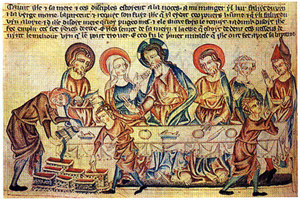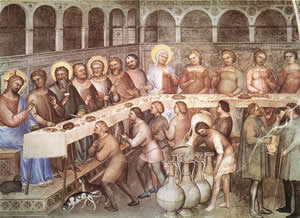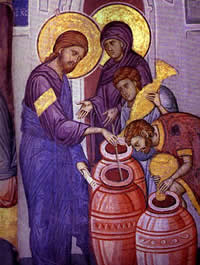The Miracle at Cana:
A Whole Lot of Strong Wine
For Sunday January 14, 2007
Lectionary Readings (Revised Common Lectionary, Year C)
Isaiah 62:1–5
Psalm 36:5–10
1 Corinthians 12:1–11
John 2:1–11
Marionite icon. |
When I moved to Moscow State University on September 7, 1991 to serve as a visiting professor in the department of Scientific Atheism (1991–1995), our family of five lived in two tiny dorm rooms with an adjoining door. Our baby Megan was eight weeks old. One of seven massive gothic buildings built in Moscow under Stalin, the university sits atop a hill overlooking the Moscow River and the 1980 Olympic Stadium. For our first five months we lived on the sixth floor in sector "G," or as the students joked with the macabre humor of gulag terminology, zona "G."
Down the hallway from us lived a striking Nigerian couple. We marveled at their fluent Russian and envied their telephone. Ayo and Fedeke sensed our culture shock and social isolation in those first few weeks, and so they invited us to join them at a Nigerian wedding in downtown Moscow. I've traveled to Africa six times and grown to appreciate how well they celebrate good times. Flashing lights, fine foods, throbbing music, colorful clothing, spontaneous laughter and untrammeled joy characterized that evening. The party culminated with an outrageous tradition of extravagance. As the bride and groom danced, we guests circled around and threw money at them. Ruble notes went flying everywhere—across the floor, in the air, and into their pockets. As the couple perspired people even pasted bills to their foreheads. Everyone roared with delight, especially when our two sons began stuffing bills into their own pockets.
 |
Wedding at Cana. |
Weddings loom large in Scripture. Isaiah compared Israel's future joy to a marriage celebration: "As a young man marries a maiden, so will your sons marry you; as a bridegroom rejoices over his bride, so will your God rejoice over you" (Isaiah 62:5). In the Gospels marriage feasts figure prominently as metaphors for God's kingdom. We read, for example, that "the kingdom of heaven is like a king who prepared a wedding banquet for his son," only to have people RSVP with lame excuses why they couldn't attend (Matthew 22:1–14, Luke 14:16–24). The parable of the ten bridesmaids urges us to remain vigilant at life-changing moments like a wedding (Matthew 25:1–13). Life in God's kingdom somehow mirrors wedding etiquette: "When someone invites you to a wedding feast, do not take the place of honor, for a person more distinguished than you may have been invited" (Luke 14:8). In his vision of the final consummation of human history, John imagined a great wedding feast between the Lamb of God and his bride (Revelation 19).
So it comes as no surprise when John says that Jesus did "many miraculous signs in the presence of his disciples" (John 20:31), but the very first one was at a wedding at Cana in Galilee, about nine miles northwest of his hometown in Nazareth (John 2:1–11). To the chagrin of the host, the wedding wine ran dry. With his mother Mary and his disciples present, Jesus filled six stone pots used by Jews for ritual washings with water (they had been empty), and then turned the water into wine. A lot of wine. Good wine. The miracle bespeaks both quantity and quality. Each pot held twenty to thirty gallons, so the result was some 150 gallons of wine, far beyond what the revelers needed. There's an inverse ratio between the trivial matter of running out of wine at a wedding and the excessive abundance that resulted. Furthermore, whereas most hosts serve the best wine first when people will appreciate the quality, and cheaper wine later when no one can taste the difference, Jesus reversed the pattern by saving the best for last. Clearly, the God that Jesus revealed is a God of lavish liberality, generosity and extravagance.
 |
Giusto de Menabuoi, 1376-1378. |
I've never witnessed a miracle, but I've often wondered how I would respond if I thought I did. John recorded the "many miraculous signs" of Jesus in order to elicit faith in those who heard about them even if they did not witness them firsthand: "These are written that you may believe that Jesus is the Christ, the Son of God, and that by believing you may have life in his name" (John 20:30–31). That's what happened at Cana when he turned the water into wine; the disciples "put their faith in him." But I can easily imagine myself falling into some crude superstition, becoming a gawker at spectacles, or disbelieving the miracle and the miracle-maker like those whom John describes (John 12:37).
The early church rejected many fables about Jesus as spurious, such as the Infancy Gospel of Thomas (c. 140–170) in which Jesus curses a playground bully who consequently dies, then raises him to life with a spontaneous wish-prayer, and turns clay pots into flying birds.The early believers were not gullible and naive when it came to sensationalist exaggerations about miracle stories. They exercised reticence and restraint. They witnessed to how the miracles of Jesus stirred controversy, division, disbelief, and sometimes even authentic faith. When some people asked Jesus to perform a miraculous sign he rebuked them for even asking. He said that if they really wanted to believe there was more than enough evidence (Matthew 12.38–39). A few pages after the first miracle at Cana, Jesus responded brusquely to a Gentile military officer who begged Jesus to heal his sick son: "unless you people see miraculous signs and wonders you will never believe." Then he healed the boy anyhow (John 4:43–44). Even false prophets, Jesus warned, could perform miraculous signs (Matthew 24:24).
 |
14th-century fresco. |
Jesus was not an ancient David Blaine, some street magician doing tricks to astound curiosity seekers. Nor were his miracles merely missions of mercy or demonstrations of God's compassion for human suffering (although they were at least that). Rather, to understand his miracles rightly meant to exercise faith in he who had performed them. His signs, wonders, works and healings forced a decision one way or another: "Believe the miracles, that you may learn and understand that the Father is in me, and I in the Father. . . Believe me when I say that I am in the Father and the Father is in me; or at least believe on the evidence of the miracles themselves" (John 10:38, 14:11).
At the wedding in Cana Jesus filled and fulfilled the ancient promises of Judaism. He filled the empty water pots used for ritual purity with copious amounts of rich wine used for human celebration. He did not merely announce a coming reign of God, or direct attention away from himself to some other. With the first of his "many miraculous signs" he demonstrated that somehow and in some unsurpassed manner he revealed the glory and character of Yahweh like no other. He invited people to drink his wine. Contrary to our contemporary hubris and condescension to people of the past, that is no more of a scandal today than it was then. To be sure, it was and is very strong wine indeed.
For further reflection
* Have you ever witnessed a miracle? How did you respond?
* Consider common responses to reputed miracles: extreme gullibility and so-called "scientific" disbelief.
* Why are miracles unable to guarantee a response of genuine faith?
* Do you think that witnessing a miracle would strengthen your faith? Why or why not?
* Lewis B. Smedes, Ministry and the Miraculous; A Case Study at Fuller Theological Seminary (1992)





